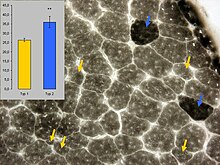Myopathy with congenital fiber type disproportion
| Classification according to ICD-10 | |
|---|---|
| G71.2 | Congenital myopathies fiber type disproportion |
| ICD-10 online (WHO version 2019) | |
As myopathy with congenital Fasertypendisproportion one is rare muscle disease from the group of congenital myopathies referred, which was first described in 1973.
clinic
Clinically, there is hypotension of the muscles at birth (see floppy infant ). Motor development is delayed if the shoulder girdle and trunk muscles are weak. It is not uncommon for orthopedic problems such as hip dislocation to occur. The course is heterogeneous and, in the majority of cases, only slowly progresses. Children with involvement of the facial and swallowing muscles seem to have a worse prognosis.
Histology and genetics
In muscle biopsy , hypotrophy of the slow type I muscle fibers is particularly noticeable in the enzyme histochemical staining for the ATPase at different pH values . A reduction in the diameter of type I muscle fibers of at least 12% compared to type II muscle fibers has been proposed as a diagnostic criterion. In the differential diagnosis, myopathy with congenital fiber type disproportion must be differentiated from other muscle diseases that can be associated with selective type I atrophy (such as McArdle's disease ).
The genetics of myopathy with congenital fiber type disproportion is heterogeneous. Families with mutations of the ACTA1 gene, which codes for the structural protein alpha-actin , and mutations of the SEPN1 gene, which also plays a role in multicore myopathy , have been described.
Individual evidence
- ↑ Brooke: Congenital fiber type disproportion, In: Kakulas (ed): Clinical Studies in Myology. Proceedings. of the 2nd International Congress on Muscle Diseases, Perth, Australia, 1971 Excerpta Medica 1973. 147-159.
- ^ Clarke & North: Congenital fiber type disproportion - 30 years on. In: J Neuropathol Exp Neurol , 2003; 62 (10): 977-89. PMID 14575234
- ↑ Laing et al .: Actin mutations are one cause of congenital fiber type disproportion. In: Ann Neurol , 2004; 56: 689-694. PMID 15468086
- ↑ Clarke et al .: EPN1: associated with congenital fiber-type disproportion and insulin resistance. In: Ann Neurol , 2006; 59: 546-552 PMID 16365872
Web links
Myopathy with congenital fiber type disproportion. In: Online Mendelian Inheritance in Man . (English)
